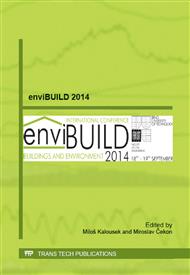p.75
p.79
p.83
p.87
p.92
p.96
p.105
p.109
p.113
Hygro-Thermal Behaviour of Timber Frame Straw Bale Construction as an Energy Efficient Building Technology
Abstract:
Due to an increasing request for ecological building constructions, in particular straw bale buildings, a research in this regard has been performed at the Vienna University of Technology. Straw bale construction is a new rediscovered building technology, which is an alternative to conventional construction technologies. The aim of this study is caring out of hygro-thermal simulation of a straw bale wall construction to design as efficiently as possible straw bale house. The choose of other construction elements for a thermal analysis (appropriate wall, roof and a base plate construction), was based on an extensive literature researche. For the examination of the building a timber frame construction has been selected. The straw bales in this construction were plastered inside with clay plaster and externally with a combination of lime and clay plaster. The roof structure was designed as a green roof and insulated with straw bales. The base plate was also insulated with straw bales. To check the thermal behavior of the structures described above were thermal bridges calculated using a FEM program. The hygrothermal behavior was calculated with HAM4D building physic software, developed on the department for Buildings Physics and Sound Protection on Vienna University of Technology. Ecological and economic evaluation of straw bale construction was carried out with reference to the data from the literature. The performed thermal (with COMSOL) and the first hygrothermal calculations (with HAM4D Software) have demonstrated a very favorable performance of the proposed building components. The achieved low U-values of the components allow the construction of passive houses. The use of self-build-service in the construction process can reduce construction costs significantly. The use of ecological materials such as: straw, clay and wood allows a low cost recycling of building materials.
Info:
Periodical:
Pages:
92-95
Citation:
Online since:
October 2014
Authors:
Keywords:
Price:
Сopyright:
© 2014 Trans Tech Publications Ltd. All Rights Reserved
Share:
Citation:


